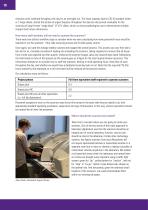 Website:
Leica Biosystems
Website:
Leica Biosystems
Group: Danaher
Catalog excerpts

The Leeds Guide to Digital Pathology
Open the catalog to page 1
INTRODUCTION The digital pathology team at Leeds Teaching Hospitals NHS Trust and the University of Leeds has 15 years’ experience and a proven track record in delivering world class digital pathology innovation and research. pathology go mainstream for the benefit of patients.” Darren Treanor, Consultant Pathologist and The path to clinical digital pathology deployment is a challenging Lead for the Digital Pathology Project at Leeds but rewarding one. Leeds Teaching Hospitals NHS Trust Teaching Hospitals NHS Trust, UK continues the journey and has gained valuable insight that will help...
Open the catalog to page 4
Defining Digital Pathology Digital pathology (DP) includes three imaging technologies: 1. Gross imaging The acquisition and storage of macroscopic pathological images to aid histological diagnosis and cancer dataset completion. 2. Telepathology The predecessor of modern whole slide imaging systems, telepathology involves the live remote control of a modified microscope, and the image is not stored on a computer system. 3. Whole Slide Imaging When people talk about DP today, they are usually referring to whole slide imaging (WSI). Also known as “virtual microscopy,” WSI is normally performed...
Open the catalog to page 5
At the onset of this project, we completed a systematic review of existing literature on DP accuracy. We identified and synthesised the data from 38 peer-reviewed publications spanning the last 20 years. We found a mean diagnostic concordance of glass slide microscopy diagnosis and digital microscopy diagnosis of 92.4%. (1), compared with a concordance rate of 93.7% for repeat microscope review of a case using glass slides. We went on to analyse, in detail, the relatively small number of discordant cases, to identify the key areas of difficulty that pathologists can experience when they...
Open the catalog to page 6
A Business Case for Digital Pathology Developing an effective business case for deployment of DP can be one of the most daunting tasks a department can face. Your first priority should be to define your “use cases” – how users will interact with the technology to achieve specific goals. We recommend a phased deployment to allow for a gradual integration and accrual of skills in both the diagnostic laboratory and the reporting desk. Our phased approach began with primary diagnosis of breast histology, neurohistology, and immunohistochemistry assessment. Improving Patient Safety Improving...
Open the catalog to page 7
Best Practice for Preparing a Business Case • egin with a clear, concise introduction, in which you describe your current laboratory and diagnostic practices and B your desire to transition to DP. Use simple terms that do not require expert knowledge of pathology processes. You will also need to summarize the pressing reasons for why your department should invest in DP. Make use of the data and references from the “Case for Adoption” paper referenced in the “Further Resources” section to add detail on the strategic context of DP. (4) • Describe the scope of investment by listing all the...
Open the catalog to page 8
Very likely Second opinion Primary diagnosis Effective Project Management For implementation to proceed smoothly and effectively, it is essential that multiple contributing components are managed and well-planned, and we believed that we would minimize our risk of project delays by hiring a dedicated, professional project manager. Our project manager has responsibility for DP deployment including management of many subprojects that synergistically contribute to total success. Our subprojects were led by various members of the DP team, and the project manager played a pivotal role in...
Open the catalog to page 9
Workflow Analysis and Process Mapping Techniques To create a baseline of our workflow, we started with the end-to-end mapping of our process. Our analysis showed significant opportunity to improve overall turnaround time for diagnostic cases, as well as a reduction in the number of touchpoints (and sources of error) along the way. Below are our top tips for process mapping: • Document your “current” lab workflow to create a value stream map. • Understand and plot laboratory pressure points, bottlenecks, and waiting time. • Create your “future” value stream map (VSM): » his map should be...
Open the catalog to page 10
Tips for an Effective Deployment • Some changes may require capital investment, but application of appropriate improvement methodologies (e.g. Lean and Six Sigma) can produce significant improvements at a low cost. • T ensure input on the current state and buy-in on the future state, we recommend holding a two-day meeting o with key personnel involved in each step of the workflow process. Spend time observing the current workflow, measuring both hands-on time and waiting time. • T ust in analytics. Remember, if it’s not measured, it can’t be improved! r Scanner Procurement and Operation...
Open the catalog to page 11
resection work collected throughout the day for an overnight run. The lower capacity Aperio CS2 (5 standard slides or 2 large slides), shared the burden of urgent biopsies throughout the day but also proved invaluable for the scanning of large format “mega-block” (2”x3”) slides, which our breast pathologists use to demonstrate multiple margins and tumour dimensions. How many staff members will we need to operate the scanners? There were two distinct workflow steps to consider when we were calculating how many personnel hours would be required to run the scanners: 1) the slide scanning...
Open the catalog to page 12
Scanner Maintenance Supports Existing Lab Workflow Suitable Bench/ Building Work Existing Infrastucture Walk Around Time Centralised Approach Option 1 – Seniors Room Option 2 – Wash Room Option 3 – Temporary Slide Storage Option 4 – Back Wall Option 5 – Equipment Storage Room Option 6 – Slide Storage Room Option 7 – Spare Bench Option 8 – IHC Area Option 9 – IHC QA Area Option 10 – Addiitional Work Area How to Save Time if You’re Running Standard and Digital Reporting Simultaneously If you decide to implement DP in a phased approach, you will inevitably encounter a stage where you have both...
Open the catalog to page 13All Leica Biosystems catalogs and technical brochures
-
APERIO VERSA
4 Pages
-
Aperio CS2
3 Pages
-
Aperio WebViewer DX User’s Guide
84 Pages
-
Aperio LIS Connectivity Overview
70 Pages
-
Aperio eSlide Manager
100 Pages
-
APERIO CLINICAL SOLUTION
7 Pages
-
APERIO I M AG E A N A LYS I S
20 Pages
-
Leica ASP6025 S
4 Pages
-
Leica VibratomeTM Series
8 Pages
-
Aperio GT 450 DX
5 Pages
-
BOND RXm
4 Pages
-
Leica St4020 Linear Stainer
2 Pages
-
HistoCore SPECTRA ST Stainer
4 Pages
-
Leica CM1520 Cryostat
2 Pages
-
Leica SM2010 R
4 Pages
-
Vibrating Blade Microtomes
8 Pages
-
HistoCore PEARL
4 Pages
-
CEREBRO
8 Pages
-
HistoCore PELORIS 3
3 Pages
-
Leica CM3050 S
4 Pages
-
HistoCore Microtomes
8 Pages
-
Leica ST5010 Autostainer X
8 Pages
-
Leica CM1860/CM1860 UV
5 Pages
-
Aperio eSlide Manager
4 Pages
-
Leica CM1950
12 Pages
-
HistoCore BIOCUT
2 Pages
-
HistoCore Microtomes
4 Pages
-
Stereotaxic Solutions
7 Pages
-
HistoCore PERMA S
4 Pages
-
Leica CM3600 XP
2 Pages
-
Leica RM2125 RTS
2 Pages
-
Leica TP1020
4 Pages
-
Leica ASP300 S
8 Pages
-
Leica IP C
12 Pages
-
Cognitive Cxi
2 Pages













































